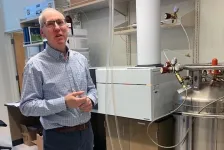(Press-News.org) A new study shows that it is possible to use machine learning and statistics to address a problem that has long hindered the field of metabolomics: large variations in the data collected at different sites.
“We don’t always know the source of the variation,” said Daniel Raftery, professor of anesthesiology and pain medicine at the University of Washington School of Medicine in Seattle. “It could be because the subjects are different with different genetics, diets and environmental exposures. Or it could be the way samples were collected and processed.”
Raftery and his research colleagues wanted to see if machine learning — a form of artificial intelligence that uses computer algorithms to process large volumes of historical data and to identify data patterns — could reduce this variation between data from different sites without obscuring important differences.
“We wanted to bring these mismatched datasets together so the findings of different studies could be compared or combined for further analysis,” Raftery said.
He led the project with Dabao Zhang and Min Zhang, formerly at Purdue University and now professors of epidemiology & biostatistics at University of California, Irvine Public Health. Danni Liu, a Ph.D. student at Purdue, was lead author of the paper, which appears in the Feb.12 issue of PNAS, the Proceedings of the National Academy of Sciences.
Raftery is an investigator at the UW Mitochondria and Metabolism Center, based at UW Medicine South Lake Union in Seattle.
The term metabolomics relates to metabolism, a word that describes chemical reactions our cells perform to maintain life. These include reactions that break down food to harvest energy and obtain the raw materials cells need for growth and repair, reactions that involve the assembly of cellular components needed for life, and reactions involved in the disassembly of damaged or unneeded components so they can be recycled, discarded or used as fuel.
The small chemicals produced by these metabolic processes are called metabolites. Metabolite levels reveal what chemical reactions are going on within a cell, tissue, organ or organism at a given moment and how those reactions may change over time.
Metabolomics is the study of metabolites and the processes that produce them.
This information helps medical scientists better understand not only how cells maintain normal function but also what might be going wrong when people fall ill. This knowledge could lead to new ways to diagnose, prevent and treat disease, Raftery said.
In the new study, the researchers built machine-learning models to identify factors that were driving the differences between datasets. The models accounted for demographic differences in the study populations, such as age and sex, and used the information contained in other metabolites to explain the observed differences.
The researchers found that their approach reduced the variation between datasets by more than 95% without obscuring meaningful differences, such as those that naturally occur between men and women.
“We’ve shown that our approach has the potential to reduce unwanted variance seen in metabolomic data while retaining metabolomic signals of interest,” Raftery said.
The group plans to expand its studies with the aim of providing a deeper understanding of normal metabolism and identifying biomarkers of abnormal metabolism that can be a sign of disease..
Written by Michael B. McCarthy
END
Machine learning promises to accelerate metabolism research
The method reduces differences, often seen between data from different sample sets, that have long hindered progress in the field.
2024-02-12
ELSE PRESS RELEASES FROM THIS DATE:
Researchers uncover a key link in legume plant-bacteria symbiosis
2024-02-12
Legume plants have the unique ability to interact with nitrogen-fixing bacteria in the soil, known as rhizobia. Legumes and rhizobia engage in symbiotic relations upon nitrogen starvation, allowing the plant to thrive without the need for externally supplied nitrogen. Symbiotic nodules are formed on the root of the plant, which are readily colonized by nitrogen-fixing bacteria. The cell-surface receptor SYMRK (symbiosis receptor-like kinase) is responsible for mediating the symbiotic signal from rhizobia perception to formation of the nodule. ...
Genetic analysis and archaeological insight combine to reveal the ancient origins of the fallow deer
2024-02-12
Modern populations of fallow deer possess hidden cultural histories dating back to the Roman Empire which ought to be factored into decisions around their management and conservation.
New research, bringing together DNA analysis with archaeological insights, has revealed how fallow deer have been repeatedly moved to new territories by humans, often as a symbol of colonial power or because of ancient cultures and religions.
The results show that the animal was first introduced into Britain by the Romans ...
Researchers studying ocean transform faults, describe a previously unknown part of the geological carbon cycle
2024-02-12
Woods Hole, Mass. (February 12, 2024) – Studying a rock is like reading a book. The rock has a story to tell, says Frieder Klein, an associate scientist in the Marine Chemistry & Geochemistry Department at the Woods Hole Oceanographic Institution (WHOI).
The rocks that Klein and his colleagues analyzed from the submerged flanks of the St. Peter and St. Paul Archipelago in the St. Paul’s oceanic transform fault, about 500 km off the coast of Brazil, tells a fascinating and previously unknown story about parts of the geological ...
Salt substitutes help to maintain healthy blood pressure in older adults
2024-02-12
The replacement of regular salt with a salt substitute can reduce incidences of hypertension, or high blood pressure, in older adults without increasing their risk of low blood pressure episodes, according to a recent study in the Journal of the American College of Cardiology. People who used a salt substitute had a 40% lower incidence and likelihood of experiencing hypertension compared to those who used regular salt.
According to the World Health Organization, hypertension is the leading risk factor for cardiovascular disease and mortality. It affects over 1.4 billion adults and results in 10.8 million deaths per year worldwide. One of the ...
Heart disease risk factors in women highlight need for increased awareness, prevention
2024-02-12
Statement Highlights:
The new scientific statement highlights heart disease as the leading cause of death for women and emerging evidence that has identified several gender-specific risk factors for heart disease in women, including complications during pregnancy and premature menopause.
Compared to men, women also have different symptoms of heart disease, are less likely to receive evidence-based therapies and are more likely to have adverse cardiovascular outcomes after a cardiac event.
Targeted public health interventions ...
SETI institute employs SETI ellipsoid technique for searching for signals from distant civilizations
2024-02-12
February 12, 2024, Mountain View, CA -- In a paper published in the Astronomical Journal, a team of researchers from the SETI Institute, Berkeley SETI Research Center and the University of Washington reported an exciting development for the field of astrophysics and the search for extraterrestrial intelligence (SETI), using observations from the Transiting Exoplanet Survey Satellite (TESS) mission to monitor the SETI Ellipsoid, a method for identifying potential signals from advanced civilizations in the ...
Sugar-reduced chocolate with oat flour just as tasty as original, study finds
2024-02-12
UNIVERSITY PARK, Pa. — The secret to making delicious chocolate with less added sugar is oat flour, according to a new study by Penn State researchers. In a blind taste test, recently published in the Journal of Food Science, 25% reduced-sugar chocolates made with oat flour were rated equally, and in some cases preferred, to regular chocolate. The findings provide a new option for decreasing chocolate’s sugar content while maintaining its texture and flavor.
“We were able to show that there is a range in which you can ...
AI-supported image analysis: metrics determine quality
2024-02-12
How well do the algorithms used in the AI-supported analysis of medical images perform their respective tasks? This depends to a large extent on the metrics used to evaluate their performance. An international consortium led by scientists from the German Cancer Research Center (DKFZ) and the National Center for Tumor Diseases (NCT) in Heidelberg has compiled the knowledge available worldwide on the specific strengths, weaknesses and limitations of the various validation metrics. With "Metrics Reloaded", the researchers are ...
Innovative decarbonization: UH researcher offers carbon-driven framework to accelerate shift toward net-zero electric power sector
2024-02-12
Houston, Texas, the epicenter of the global energy market, and the University of Houston – the Energy University – are leading the transition towards a cleaner, more sustainable future with innovative solutions.
With three-quarters of U.S. greenhouse gas emissions stemming from burning fossil fuels for energy, it's clear that the key to curbing emissions lies in reimagining how energy is produced and consumed. In Texas, the shift is already well on its way. Technologies like giant batteries, ...
White people more likely to confront authors of racist online posts to set discussion rules
2024-02-12
CHAMPAIGN, Ill. — White people surveyed in a recent study indicated they would be more likely to confront those who post racist content on social media if their objective were to defend the norms for political discussions rather than to change the person’s prejudiced beliefs.
Communication professors Stewart M. Coles of the University of Illinois Urbana-Champaign and Daniel S. Lane of the University of California, Santa Barbara surveyed people during the 2020 U.S. presidential election cycle to explore the conditions under ...
LAST 30 PRESS RELEASES:
The impact of family dynamics on eating behaviour – how going home for Christmas can change how you eat
Tracing the quick synthesis of an industrially important catalyst
New software sheds light on cancer’s hidden genetic networks
UT Health San Antonio awarded $3 million in CPRIT grants to bolster cancer research and prevention efforts in South Texas
Third symposium spotlights global challenge of new contaminants in China’s fight against pollution
From straw to soil harmony: International team reveals how biochar supercharges carbon-smart farming
Myeloma: How AI is redrawing the map of cancer care
Manhattan E. Charurat, Ph.D., MHS invested as the Homer and Martha Gudelsky Distinguished Professor in Medicine at the University of Maryland School of Medicine
Insilico Medicine’s Pharma.AI Q4 Winter Launch Recap: Revolutionizing drug discovery with cutting-edge AI innovations, accelerating the path to pharmaceutical superintelligence
Nanoplastics have diet-dependent impacts on digestive system health
Brain neuron death occurs throughout life and increases with age, a natural human protein drug may halt neuron death in Alzheimer’s disease
SPIE and CLP announce the recipients of the 2025 Advanced Photonics Young Innovator Award
Lessons from the Caldor Fire’s Christmas Valley ‘Miracle’
Ant societies rose by trading individual protection for collective power
Research reveals how ancient viral DNA shapes early embryonic development
A molecular gatekeeper that controls protein synthesis
New ‘cloaking device’ concept to shield sensitive tech from magnetic fields
Researchers show impact of mountain building and climate change on alpine biodiversity
Study models the transition from Neanderthals to modern humans in Europe
University of Phoenix College of Doctoral Studies releases white paper on AI-driven skilling to reduce burnout and restore worker autonomy
AIs fail at the game of visual “telephone”
The levers for a sustainable food system
Potential changes in US homelessness by ending federal support for housing first programs
Vulnerability of large language models to prompt injection when providing medical advice
Researchers develop new system for high-energy-density, long-life, multi-electron transfer bromine-based flow batteries
Ending federal support for housing first programs could increase U.S. homelessness by 5% in one year, new JAMA study finds
New research uncovers molecular ‘safety switch’ shielding cancers from immune attack
Bacteria resisting viral infection can still sink carbon to ocean floor
Younger biological age may increase depression risk in older women during COVID-19
Bharat Innovates 2026 National Basecamp Showcases India’s Most Promising Deep-Tech Ventures
[Press-News.org] Machine learning promises to accelerate metabolism researchThe method reduces differences, often seen between data from different sample sets, that have long hindered progress in the field.









